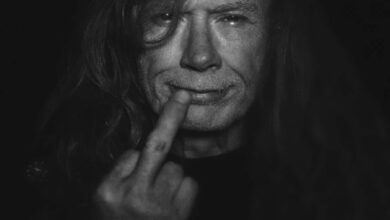Metal Vocalist Transforms “A Whiter Shade of Pale” into a Stunning, Emotion-Charged Modern Revival
When Erik Grönwall emerged with his renewed interpretation of A Whiter Shade of Pale, it instantly felt different from the usual flood of online covers. It came across as a musician with classic-rock roots reaching toward one of 1967’s most enigmatic and endlessly debated songs, saying, “This lived in my childhood. I know its sadness, and I can translate it for 2025.” He wasn’t attempting to imitate Procol Harum’s signature sound; he aimed to show what happens when a modern Scandinavian rock voice meets a baroque-pop relic from the Summer of Love and reshapes it with sincerity.
Longtime followers who have tracked Grönwall since his Swedish Idol victory already knew he wasn’t afraid of tackling big, intimidating material, yet this song choice still caught many by surprise. A Whiter Shade of Pale isn’t the kind of track that singers use to show off their range. It’s not built for vocal gymnastics or dramatic high notes. Instead, it’s a slow, dreamlike puzzle that relies heavily on its Bach-inspired organ line and its surreal, open-to-interpretation lyrics. While many performers hide within its misty phrases, Grönwall stepped into that fog with intention, treating it like a story that deserved to be told plainly.
The charm of the performance came from how unaffected and natural it sounded. Rather than opening with heavy guitars or a cinematic buildup, he introduced the melody with a light touch, enough for listeners to instantly recognize the classic but not feel overwhelmed by homage. From there, he added his trademark rock edge carefully, letting grit seep into certain phrases while keeping the arrangement understated. Even in a simple video shoot, his skill with dynamics was clear—quiet, conversational verses that gradually swelled into a chorus sung like a memory rediscovered in real time.
Part of what made the rendition resonate so strongly was the personal history behind it. Grönwall has often mentioned that he grew up surrounded by 50s–60s music—songs his father played early in the mornings in a modest apartment. Procol Harum’s classic belonged to that soundtrack. That makes this less of a calculated career move and more of a heartfelt return to the music that shaped him. When artists sing songs tied to their early years, their tone softens, their phrasing becomes more intimate, and you could hear that tenderness subtly woven into his delivery just before he let his voice open up for the chorus.
What truly elevated the performance was his decision not to replicate Gary Brooker’s dignified, distant interpretation. Brooker sang the original as though witnessing something mysterious drifting past him. Grönwall approached it differently—like someone who has survived illness, abrupt career turns, and personal reinvention, choosing to sing forward instead of looking back. The contrast between 1967’s surreal melancholy and Grönwall’s lived resilience created a fresh emotional fingerprint. It was the same melody carrying new weight, shaped by the life of someone who has already weathered storms.
Listeners also felt the care he brought to the song’s famously ambiguous lyrics. Over the years, interpretations have ranged from heartbreak to intoxication to spiritual symbolism. Instead of clarifying or modernizing the meaning, Grönwall embraced its disjointed, impressionistic nature, positioning the lyric emotionally rather than literally. A hint of ache in the opening line, a slight lift in “as the miller told his tale,” and a gentle tightening near the end created an arc that felt quietly human. By allowing the lyrics to remain cryptic while singing them with intention, he made a decades-old song feel both familiar and newly breathing.
Another reason the video spread quickly was the contrast it provided. Fans had watched Grönwall belt out powerhouse anthems—soul, pop, metal—and here he was approaching a British psychedelic classic with restraint, adding just enough rock influence to refresh it without overwhelming its melancholy. That kind of contrast is compelling. It signals that the artist isn’t just singing covers—he’s building a curated musical lineage. Because A Whiter Shade of Pale is deeply ingrained in generational memory, viewers from different ages and backgrounds connected with it instantly.
The arrangement itself struck a balance between homage and modernization. Where Procol Harum leaned on the iconic Hammond organ to create a cathedral-like dreamscape, Grönwall kept his vocal more present and unembellished, giving the song a confessional, almost private feel. It no longer sounded like a distant performance echoing from the late 60s; it felt like someone in the same room, speaking through a melody he loved. This closeness is a hallmark of his recent interpretations—he takes well-known classics and pulls them closer to the listener’s ear.
People also noted how comfortable he appeared while performing it. That matters more than most realize. When a singer tackles a beloved classic and looks tense, audiences brace themselves for flaws. But when the performer seems at ease—like someone sharing a personal favorite rather than auditioning—the audience softens too. Grönwall embraced that ease fully. He smiled, let pauses stretch naturally, and allowed his signature rock rasp to lift certain sustained notes, making the performance feel unforced and authentic.
What makes this release particularly interesting is how it fits into his post–Skid Row artistic evolution. After stepping away from the band to prioritize health and personal stability, he didn’t fade from view. Instead, he began releasing thoughtfully chosen covers that link classic pop, rock, and soul. Choosing A Whiter Shade of Pale is a signal: he’s crafting a catalog rooted in nostalgia, musicianship, and emotional honesty. It’s a low-budget, high-impact approach that suits an artist with multiple fan bases from Idol, H.E.A.T., and Skid Row.
The emotional resonance adds another layer. When someone who has openly fought leukemia sings about something pale, faint, slipping away, listeners interpret it through that lens even if he never mentions his past. His voice carries both vulnerability and strength, and people hear that duality. That’s why comment sections on his videos often read like shared reflections rather than arguments—viewers aren’t just reacting to a song; they’re projecting their own resilience onto his interpretation.
It’s also worth remembering that this song has been covered countless times—by Annie Lennox, King Curtis, pub bands, wedding performers, and cruise-ship acts. Standing out among so many versions is extremely difficult. Grönwall succeeded by giving the song a sense of ownership. He framed it with a personal memory and sang it with the conviction of someone reclaiming a piece of his musical upbringing. Viral covers today only work when they feel like genuine reinterpretations rather than replicas, and this one passed that test immediately.
For fans who have watched his recent reimaginings—his gritty metal-tinged take on Billy Idol’s White Wedding or his soulful street-corner reading of Robbie Williams’ Angels—the pattern was unmistakable. He’s weaving together songs from different corners of rock and pop history using the same unmistakable voice, proving that he can shift between genres without losing identity. That flexibility is one of the reasons his channel continues to grow.
The atmosphere of the song itself also helped listeners imagine potential live settings. It’s easy to picture him performing it in an intimate theatre backed by a string quartet, or in a dimly lit club with a Hammond organist, or even on a cruise packed with classic-rock fans. Unlike some of his more explosive selections, this track feels timeless enough to remain in his setlist for years, adapting effortlessly to different stages and arrangements.
What ultimately makes the performance stand out is the way it fuses eras through his voice. The song brings its dreamy 1967 haze, poetic ambiguity, and church-organ grandeur. Grönwall brings the emotional clarity of the 2020s—survival, reflection, and a renewed gratitude for meaningful songs. Together, they create a version that doesn’t just revisit a classic; it reframes it as something still speaking loudly in the present moment.
And that is why the clip spread so quickly: it wasn’t an algorithm-chasing stunt, but an artist gently revisiting a song that shaped him, listening to it all over again, and then letting his own voice tell the story. In a crowded digital landscape, that kind of deliberate, heartfelt performance still has the power to stop people mid-scroll.





